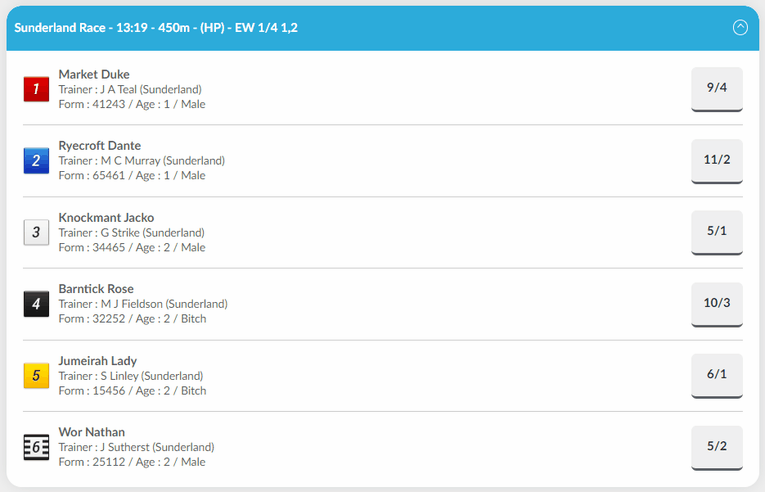Greyhound racing involves greyhounds chasing an artificial lure and is often used as a betting event. The aim of the race is for the dogs to chase and catch the lure before reaching the finish line.
Greyhound Racing Betting: Bet Types, Tips & Strategy
Table of Contents
How to Bet on Greyhounds – Greyhound Racing Betting Tips
Greyhound racing has been a popular form of betting for centuries. This fast-paced sport offers an exciting opportunity to bet on the outcome of a race. With the help of expert trainers, these dogs can reach speeds of up to 45 mph and are incredibly agile. For those looking to bet on greyhounds, there are several strategies and tips that can lead to more successful outcomes.
By understanding the various aspects of this sport, as well as learning how to properly place bets, one can increase their chances of winning big when betting on greyhounds. In this guide, we’ll provide detailed information about the rules, techniques and strategies associated with betting on greyhounds and help you become a successful gambler in no time.
What Is Greyhound Racing?
Greyhound racing involves greyhounds chasing an artificial lure and is often used as a betting event. The aim of the race is for the dogs to chase and catch the lure before reaching the finish line.
Greyhound racing originated in coursing, where two greyhounds were released from their pens and chased a game animal, such as a hare or rabbit, across open fields. In coursing, the dog who caught the animal was declared the winner. This game was then adapted to include greyhounds chasing an artificial mechanical lure instead of an animal.
Modern greyhound racing, however, takes place on oval-shaped tracks with sand or dirt surfaces. These tracks range in size from 400m to 900m long with different distances depending on the race type and age of the participants. Greyhounds can reach speeds up to 65 kilometers per hour when they are chasing after their prey and can complete one lap in around 30 seconds! To ensure fairness in these races, each dog wears either an earphone headpiece or a muzzling device to limit its ability to make sharp turns while running.

Types of Greyhounds Racing Bets
There are several different types of greyhounds that can be raced. The type of greyhound selected for racing largely depends on the individual racetrack and the preference of the owner or trainer.
There are three main varieties: American Greyhounds, English Greyhounds, and Irish Greyhounds. American Greyhounds typically have longer legs and wider bodies than their English or Irish counterparts, making them better suited for sprinting over short distances. English Greyhounds have a more athletic build with long legs and leaner bodies; they are well-suited to running further distances at higher speeds. Finally, Irish Greyhounds tend to be lighter in build with shorter legs and are ideal for running longer races at lower speeds.
When it comes to betting on greyhound races, there are several types of bets available to choose from. The most popular type is the straight bet, which involves wagering on whether a particular dog will win or place (finish first or second). Other popular bets include Quinielas (betting on which two dogs will come in first and second place), Exactas (betting on which two dogs will finish first and second in either order) and Trifectas (betting on which three dogs will finish in first, second, and third). Some bettors also enjoy mixing up their bets by combining all three types into one wager known as a “box” bet.
The Greyhounds Race Program Explained
The greyhound racing program involves a variety of steps and processes that must be followed in order to ensure fair and safe competition. Before the race begins, all entrants must pass a series of vetting procedures including physical examinations, drug testing, and weight checks. Once these have been completed, the dogs are placed into categories based on their age, gender, and performance level. After this process is complete, trainers assign handicap weights to each dog’s running gear in order to level the playing field for all competing animals.
In order to ensure fairness during the race itself, judges set up lanes for each dog so that they run on even terrain. Once the race begins, spectators cheer on their favorite contestants from behind a secure fence as well as watch live feeds from cameras placed strategically around the track. Judges use video replay technology to review calls made during races and make sure that no one has broken any rules or regulations during competition.

Greyhound Betting Tips
Know the Different Types of Bets
Different types of bets can be placed according to how much one wishes to risk and the desired returns. The most common types of greyhound betting are straight wagers, quinella bets, trifectas, superfectas, parlays and round robins.
When placing a straight wager, the bettor selects one dog that he or she believes will come in first place. If that dog does indeed win, the bettor will receive their winnings based on the odds given.
Quinella bets require picking two dogs that must come in first and second place respectively for the bettor to be rewarded; this type of bet has lower potential payouts than other methods.
A trifecta bet seeks to predict which three dogs will finish first, second and third in order; this type of wager has higher potential rewards but is also more difficult as it requires more knowledge about the individual participants’ performances at different venues.
Superfecta bets are similar but specify which four dogs will come in first through fourth places respectively; these have generally higher payouts associated with them but also more challenging criteria when trying to pick them correctly.
Parlay bets involve combining multiple individual greyhound racing selections into one single wager; if all predictions are correct then some very high potential payouts can be earned from this type of wagering as well as greater overall risk because each selection must win for the payout to be awarded.
Round robin bets differ slightly from parlay bets as they involve grouping several individual choices together so that any two of them must win for a payout to be awarded; this provides a better chance at winning while still allowing for bigger payouts due to multiple selections being combined together under one single ticket purchase.
Never Skimp on Research
Spending time researching the dogs, racetracks, and form guides can help you make better decisions when placing bets.
When researching greyhounds, look for things like their age, weight, and track record. This information can give you an idea of how well they may perform in any given race. Additionally, looking at the breeding of each dog is important since some bloodlines are more suited to certain tracks than others. Studying each greyhound’s past performance history is also essential as this will give you an indication of how they typically fare against their opponents and on different surfaces or courses.
Another useful tip for greyhound betting success is familiarising yourself with the racetrack conditions and form guides prior to placing your bets. Knowing which dogs typically do best on that particular track surface or course can give you an advantage when making your picks. Additionally, pay attention to the form guides so you can get an indication of which dogs have been performing well leading up to the race day.
Understand the Odds
Betting odds represent the expected probability of a specific dog winning the race and are usually represented as a fraction or in decimal form.
In greyhound betting, there are three types of bets; win, place, and show. A win bet requires you to select which dog will come in first place, while a place bet requires you to choose which dog will finish either first or second. A show bet requires you to pick which dog will finish either first, second, or third. The odds for each type of wager depend on the likelihood of any given dog making it into one of those positions. As such, different bookmakers might offer different odds for each type of wager so it’s important to shop around and compare different bookmakers’ offerings before placing your bets.
When interpreting greyhound racing odds it is important to take into account factors such as past performance, track conditions and the current form of each dog involved in the race. It can also help to look up veteran handicappers’ predictions online before deciding which dogs have the best chance of winning – these individuals often have extensive knowledge about greyhound racing and can be a valuable source of information when trying to determine which dogs are most likely to win a particular race.
Never Bet More Than You Can Afford to Lose
It is important to always remember that greyhound racing is a gambling activity, and like all gambling activities, there is an element of risk involved. It is essential to always keep in mind that no matter how much research you put into your bets and how careful you are with your selections, you can never guarantee a win. Therefore, it is important for any serious bettor to never wager more than they can afford to lose.
The best way to ensure that the risk associated with greyhound betting remains manageable is by setting a budget for yourself and sticking to it. Before placing any bets on the races, sit down and figure out what amount of money you feel comfortable spending. This doesn’t necessarily mean that you should only bet whatever small amount of spare cash you have lying around; rather, it means taking into account your income as well as other financial obligations when determining your budget for greyhound betting. After deciding how much money you want to spend on bets each month or year, stick to this amount religiously in order to prevent any unnecessary losses.
Another valuable tip when it comes to greyhound betting is to avoid chasing losses or “going on tilt” after suffering multiple losses in a row. While it may be tempting to try and win back lost funds through bigger wagers, this strategy almost always leads to disastrous results in the long run. Instead of trying higher stakes bets in an attempt at recouping your losses, remain level-headed and continue making measured decisions while adhering closely both to your budget and research methods.
Finally, keeping track of both wins and losses during greyhound betting can help create an accurate picture of where one stands financially at the end of each day or month. Maintaining up-to-date records regarding performance will allow for better adjustments in future betting strategies as well as greater insight into overall profit levels over time. When combined with a strict budget policy for keeping risks low as discussed earlier, tracking gains/losses should help create a solid base from which one can enjoy their experience of greyhound racing without putting too much strain on their finances.
Stick to Your Strategy
The best way to get the most out of greyhound betting is to establish a plan and stick with it. This means understanding the basics such as the runner’s form, track conditions and track bias before making any bets. It also means finding value bets and managing your losses properly.
By following a set strategy, you will have greater control over your betting decisions. You will also know when you should take risks and when it’s time to take a step back and reassess your approach. Doing research beforehand is vital for success in greyhound betting, as it allows you to identify potential opportunities that could bring profit. Keeping track of past performance, current form, injuries and other factors can help you make informed decisions about which dogs are likely to perform better than others on a given day or at a particular race meeting.
In addition, sticking to your strategy helps reduce emotional betting decisions, as these can lead to costly mistakes. Instead of placing bets based on emotion or hunches, use logic and look for value in the odds offered by different bookmakers. Remember that while luck may sometimes play an important role in determining the outcome of certain races or bet types, good preparation and knowledge are essential if you want consistently excellent results when greyhound betting.
Finally, always keep careful records of your wagers so that you can review them after each race meeting or bet type has been completed. This lets you see where exactly your winnings or losses lie, as well as what areas need improvement upon or strategies need tweaking going forward. By doing this, you’ll be able to fine-tune your approach so that it suits both short-term successes as well as long-term profitability when greyhound betting.
Quit While You’re Ahead
For any gambler, successful money management is key. Understanding when to take your winnings and walk away can help ensure you don’t blow your entire bankroll in one bet. It’s critical for greyhound bettors to learn the basics of wise money management before they ever place a bet. This means determining what their maximum amount of money they are willing to risk per race and setting limits on how long they will stay at the track before calling it quits.
When evaluating which greyhounds have the best chance of winning, keep in mind that not all races are created equal. Analyzing past performance records and trainer notes can provide valuable information about each dog’s performance in different types of terrain or conditions, race lengths, etc. You should also take into consideration recent injuries or illnesses that could affect their ability to run at full speed in order to get an accurate assessment of each greyhound’s chances.
Bottom Line
Greyhound betting tips can be a great way to maximize your chances of success when betting on greyhounds. By researching the form of various dogs, the pedigree and quality of the trainers and kennels, as well as looking at past form and statistics it is possible to identify potential profitable betting opportunities. Additionally, learning and understanding the basics of how to place bets, using wagering strategies such as staking and hedging, can further enhance your success rate. With careful analysis, research and understanding of greyhound racing it is possible to enjoy long-term profits from betting on this exciting sport.
Frequently Asked Questions
What countries are greyhound racing still legal?
Some of the most popular destinations for greyhound racing include the United Kingdom, Ireland, Australia, New Zealand, Vietnam and Macau.
Has greyhound racing been banned?
Greyhound racing has been banned in some countries, including New Zealand and Spain. In the United States, it is still legal in certain states, but limited either through legislation or local referendums.
Is a greyhound faster than a horse?
A greyhound can reach speeds of up to 45 miles per hour, while a horse can run at a maximum speed of 30 to 35 miles per hour.
How much does a racing greyhound cost?
Race-ready greyhounds that have already been prepped to compete with the necessary vaccinations, spaying or neutering, dental work, etc. may cost up to $4,000 or more.
How long do greyhounds live after racing?
A healthy greyhound that has been retired from racing can live between 12-15 years, though some have been known to live even longer.


















